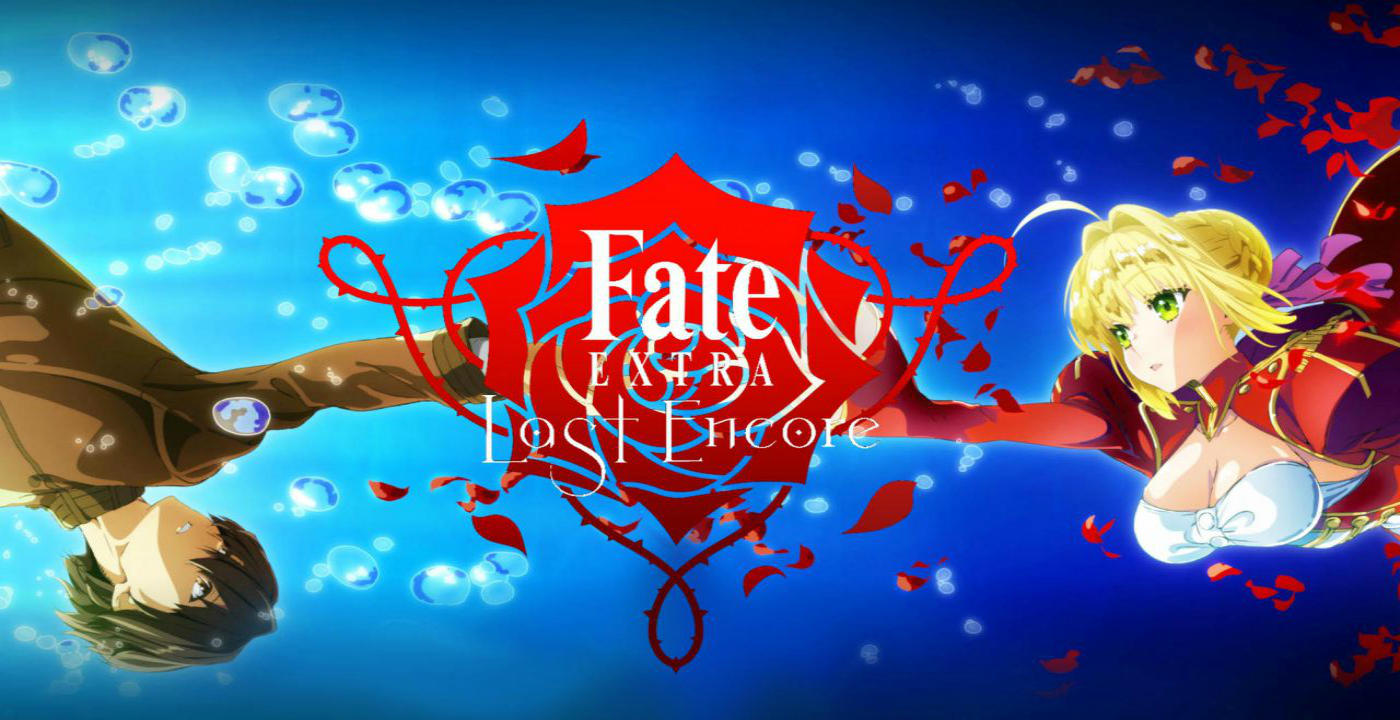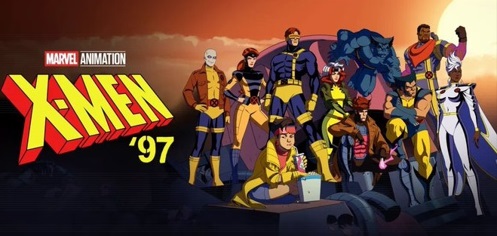English Dub Season Review: Fate/Extra Last Encore Season Two
“What an artist dies in me!”
Overview (Spoilers below, both for seasons one and two!)
Hakuno, Nero, and Rin ascend to the seventh stratum to battle Leonard B. Harway. Leo’s servant Gawain explains that, after surrendering to Nero and fem!Hakuno a millennia ago, Leo was given a second chance by Twice and stayed on this stratum, although he’s been asleep for 900 years.
Nero honors fem!Hakuno, recalling that she won her Holy Grail War but was killed by Twice before she could make a wish. Rin believes that they can save humanity by reprogramming the Moon Cell, and Hakuno is motivated to try. Gawain awakens Leo, who points out that Rin’s plan would delete Hakuno from existence. The battle commences—until Gawain defeats Nero and Hakuno with his noble phantasm. Twice scoffs at Leo’s plan for a paradise where “where thoughts cease to exist” and humans live in stagnation; he believes that “warfare is the true path to evolution.”
Nero and Hakuno are knocked to the lowest stratum, but they use Alice’s bookmark to return to the seventh. Hakuno decides to go through with his plan, even if it results in his destruction. In this battle, Nero and Hakuno are totally in-sync. Using her noble phantasm, Nero destroys Gawain. Hakuno explains that his real wish is just to live.
Hakuno and Nero advance to the Moon Cell. Twice grew up in a war zone, died, and became an NPC and then a master. He was unable to obtain the Holy Grail as an NPC, so he tried to turn fem!Hakuno into his successor, but she rejected his ideology. Now, Nero can’t seem to land a shot on Twice. He reveals himself to be a Dead Face, claiming he’s given up on his ideology and plans to destroy SE.RA.PH using his old servant’s noble phantasm, Chakravartin. He shows them that Earth has become a barren wasteland through his efforts to eradicate humanity. Twice attacks the group, but Leo protects them.
The gang realizes they don’t need to take out Twice; they just need to get to the Moon Cell. Leo and Gawain die trying to destroy Chakravartin. Nero and Hakuno take up where they left off while Rin enters the Moon Cell. Hakuno stays by Nero’s side as she vanishes, remembering a promise that fem!Hakuno made. Then Hakuno soars up to the Moon Cell, ignoring Twice’s attacks, and resets the last thousand years.
Our Take
So I’m going to ask the question on everyone’s minds—why did Netflix divide Fate/Extra Last Encore into two seasons? I mean, there are only three episodes in this season, and it’s pretty obvious that they’re intended as a finale to season one, which ended abruptly with a ton of loose ends left untied. Even the intro and ending song stay the same. Season one didn’t feel complete without this ending, and season two doesn’t pass as a real season with only three episodes (no offense, BBC Sherlock). So what gives, Netflix?
Because it’s so obvious that these two pieces—titled “Oblitus Copernican Theory” and “Illustrias Geocentric Theory,” respectively—were intended to form one coherent story, it would follow that this season replicates many of the same strengths and weaknesses as the last. Season two’s animation, music, themes, and characters (Nero is my waifu) are still on point. When it comes to flaws, Fate Extra Last/Encore is yet again lacking in the, uh, making sense department. But because this season is essentially one long battle, understanding the finer details of Hakuno’s world matters far less here. And it’s easier, for example, to distinguish between SE.RA.PH and the Moon Cell once I can actually see the Moon Cell with my own eyes (SE.RA.PH is the computer simulation they’re in and the Moon Cell is the program that governs it, right? Right?).
Many season one plot holes are solved here—the surprisingly likable Leo comes back to play a crucial role, and Hakuno’s tortured vision of his fiery past turns out to be a memory of Twice’s life on earth (as an amalgam of dead souls, Hakuno has access to the memories of many dead people, I’m assuming). So my main complaints about season one are somewhat mollified here. In fact, I really enjoyed this big finale.
First of all, the animation in this series continues to blow me away. The stunning seventh stratum boasts a tricolor sunset, full-bodied yellow tulips, and even some gorgeously-painted rocks. The area also features Roman-style columns and what appears to be the ruins of the Colosseum, a nice nod to the history of everyone’s favorite saber Nero Claudius. Characters’ faces are expressive, and the sketchy style they’re rendered in is distinctive and charming. The angelica cage is intricate and grand, Twice’s enormous Dead Face grin is terrifying, and Dead Face bodies swirl with visually pleasing purples.
The main reason I was excited to come back to this show, though, is the tender and surprising relationships that form between characters. When Nero sets down a flower in honor of the female Hakuno, her eyes display an enormous amount of grief and adoration for her formal master. Flashbacks to their time together paints their relationship as tender and intimate; somehow, this show has made me care deeply about a couple even when I haven’t even met one of the participants!
Male Hakuno and Nero share a similarly meaningful bond. Instead of Hakuno commanding Nero to do his dirty work in battle, she explains that a good master and servant “become a source of power for each other.” He lends her his strength, even if that means his body cracks and bleeds; in her dying moments, she lends him her sword. The real-world emperor Nero committed suicide paranoid and virtually friendless, so it makes sense that this Nero would be terrified of dying alone. That’s why it’s even more powerful that Hakuno sends Rin after the Moon Cell so that he can keep his promise to Nero and stay by her side until the end. As gorgeous music swells, Nero praises the person that Hakuno has become. Heck, everyone gets an emotional exchange in this season finale. Gawain and Leo’s dedication to each other is heartwarming. And even in the most crucial moments of this battle, Rin makes sure to let Hakuno know that he doesn’t have to sacrifice himself. In return, Hakuno reminds Rin how strong she is: “You fought to better yourself. You did whatever you could to fix your mistakes. Your dedication is worth so much more than I could ever dream.” I’m definitely team Hakuno/Nero here, but Hakuno and Rin’s friendship is also pretty great.
In season two, this show tackles the big questions: Is human society meant to last? Do people even deserve to keep on existing? What’s the best way to save humanity from the crises we’ve gotten ourselves into? Is war really the root of human progress? Should we look towards the past and try to atone for our mistakes, or keep the status quo in the hopes that things don’t get worse—or should we move forward, and trust in the future? Dialogue explores these questions in nuanced and thoughtful ways. Themes of recovery abound here, both in relation to the human race and to individuals—like Hakuno, who began this tale with no identity and comes out of it with a fiery purpose. “I kind of feel like it’s not that people continue living because they have the will to do something,” says Rin. “I think it’s so that they can find something to do.” And that’s what’s kept Hakuno going all this time: a search for his purpose.
But Hakuno’s motivations are pretty complex. Although he wants nothing more than to live, he is willing to give up his life for the sake of humanity, for the sake of having a mission, for the sake of seeing what will happen. He can’t stop moving once he’s decided to act, to move forward. He can’t save himself if it means staying stagnant. After all, Leo, who believes only in stagnation, directly admits that he has lost the will to live. Hakuno doesn’t know if humans deserve to live, but he wants to be one all the same.
This season has interesting things to say about violence, too. Nero explains the difference between hatred and anger—hatred is unhealthy, directed at a specific person, but anger manifests towards another’s actions, towards wrongs that have been done to human society, and should be acted upon. On a different note, although Twice detested war more than anything in the world (his last name is literally “Peaceman”), he felt compelled to replicate it because it was all he knew. But despite his best efforts, even war was not able to destroy the resilient and resourceful human race. When one is acting on righteous anger, violence can even be a good thing—“I will kill Twice, curse the world, and save it,” says Hakuno. Human actions are wonderful and versatile. It all depends on your motivations, and what you choose to do with the power you possess.
As for the voice acting in this season, Cassandra Lee Morris continues to deliver a delightful performance as Nero that’s just the right blend of supportive and haughty. Billy Kametz is hit or miss as Hakuno—his voice is right for the part, but his line readings are sometimes a little stilted. Laura Stahl is lots of fun as Leo (I can’t help but wonder why a woman is playing this adult man, but hey, I’m not complaining about his adorable androgyny). In general, the English dialogue is delightfully flowery, lending nearly every conversation a dramatic air.
Of course, this wouldn’t be Fate/Extra Last Encore if I didn’t come away confused about a fair number of things. What’s up with this bookmark, and what does it have to do with the sky? Did Hakuno only rewind time on SE.RA.PH, or did he do so on Earth as well? Why is Rin blonde in the final after-credits scene? Why did the character designers make Nero wear a dress where we can see her whole ass? And of course, the real worry that occupies my mind—did Hakuno survive?!
But not every question needs to be answered. I’m content with not knowing whether Hakuno lives or not because his ideology will live on after him. I’ve got to move forward, too.



























Hi Ashley, thank you so much for reading and we love the feedback. Note that on that day we had 14th posts go up and only ten posts show on the front page, so it's possible the preview had already been archived by the time you got to it. One recommendation would be to add our RSS feed to your favorite news aggregator service like Feedly, this way you get all of the latest posts!